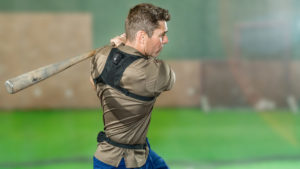The question on every baseball player’s mind is: besides more practice, how can I improve my batting skills?
Most people would assume it comes down to practice and strength training, but according to Joe Lemire, a sports reporter at SportTechie, the answer actually lies in the biomechanics of the swing. An in-depth description of the intricacies of the biomechanics that are involved in a baseball swing can be found in David Fortenbaugh’s dissertation here.
Many professional baseball teams and some training facilities, including Driveline Baseball in Seattle, have turned to using a K-Motion vest to record and analyze different aspects of a baseball swing. This wearable technology started as an analysis for golf swings, but the technology has now been implemented in baseball. Initial installations of this technology were much more expensive and not portable, but engineers have found ways to translate these technologies into wearable devices that can be used in more natural situations.
Prior methods of swing analysis left many unanswered questions and didn’t provide athletes with proper information for improvement. The K-Motion vest collects data on the speed and bend in a player’s torso and pelvis, and the rotation of their body. The portability of the vest allows for it to be used in game-like scenarios and provide useful information. The data that can be extracted from the K-Motion vest can be used to fix mechanical flaws in a player’s swing.
The K-Vest uses four different sensors to measure the rotational velocities of the torso, hips, lead arm, and bottom hand. The four sensors are placed above the elbow on the lead arm, on the back of the lead hand, on the tailbone, and on top of the thoracic spine. The velocities are compiled into a graph, and the peak velocity of each sensor can be analyzed to track the transfer of energy throughout the swing. Through use of the K-Vest, they have found that to elevate one’s hitting ability comes down to the transfer of energy from pelvis and torso rotation to their arms and wrists.
In order to fix the mechanics of a swing, the system has to obtain an understanding of what a good swing is by compiling data from a variety of professional players. On the graph produced with each swing, the range for pro hitters is displayed to give the user an idea of how they compare. Some more information about the kinematic analysis of the data can be found here.
An example of the data that the user receives from the system and how it can be used to improve a player’s swing can be seen in this video:
Though already proven useful in baseball and golf, people are finding that it can also be useful in volleyball, running, skiing, and other forms of physical activity. The use of this technology has become much more common as professional players have found the feedback to be constructive.
For more information about this technology, check out K-Motion’s website, and see here how it’s being used in golf.
Featured image from “Boscan swinging” by Minda Haas Kuhlmann which is licensed under CC BY 2.0.


